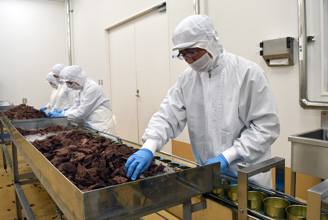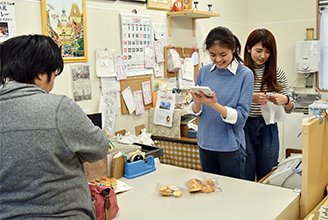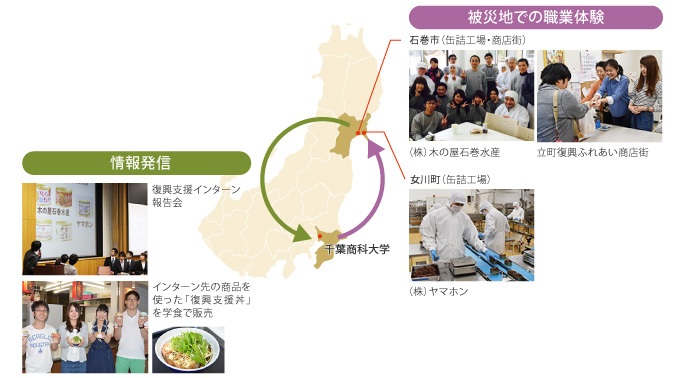Finding solutions to social issues through support for areas affected by the Great East Japan Earthquake
Social workers provide appropriate advice and assistance in solving problems in social life. Faculty of Humanities and Social Sciences Students who aspire to this job are at the "Social Worker" program. In order to cultivate the ability to understand the demands of society and the needs of people and to develop solutions, Takayuki Teshigawara's Associate Professor seminar actively engages in practical activities in a wide range of fields and interacts with people. Among other activities, the seminar continues to work to understand issues that need to be addressed in Japan as a whole in the future, such as reconstruction of areas affected by the Great East Japan Earthquake and support for evacuees, and to devise and implement solutions to these issues.From February to March 2016, nine students participated in a "reconstruction assistance internship" to gain work experience at a disaster-stricken company in Miyagi Prefecture.
What is a Reconstruction Support Internship?
The purpose of this event is to help prevent the disaster from being forgotten and to prevent rumors from spreading, to develop human resources who will work to support reconstruction efforts, and to contribute to the revitalization of industries in the disaster-stricken areas and the entire region by having university students from all over the country learn about the current situation of the disaster-stricken areas and companies affected, as well as the progress and challenges of reconstruction, and to widely disseminate their own experiences.The event is hosted by Reconstruction University, which was established after the Great East Japan Earthquake by universities and technical colleges that are members of the Sendai Academic City Consortium in cooperation with Miyagi Prefecture and local governments to promote projects aimed at the reconstruction and revitalization of Tohoku, and is co-hosted by the Miyagi Reconstruction Bureau of the Reconstruction Agency, among others.
 The real Tohoku that is not reported in the media: See the current situation in the disaster-stricken areas with your own eyes
The real Tohoku that is not reported in the media: See the current situation in the disaster-stricken areas with your own eyes
Is reconstruction progressing?

In February 2016, just before the fifth anniversary of the Great East Japan Earthquake, nine second-year students (at the time) from Teshigahara's seminar arrived in Miyagi Prefecture to participate in a "Reconstruction Support Internship." The seven-day program took place in three locations: a seafood processing company and a shopping district in Ishinomaki City and Onagawa Town.
Before visiting the area, most students imagined that "reconstruction must be progressing well." Recent news reports have tended to focus on positive topics about reconstruction, and interest in the disaster-stricken areas is fading as time passes. Rather than relying on the news, the only way to learn about the progress of reconstruction and issues that need to be resolved is to visit the area and hear directly from the people. The students in Teshigahara's seminar decided to participate in the internship because they wanted to see the current state of the disaster-stricken areas with their own eyes and think about what they can do in the future.
The challenge for the disaster-stricken areas is to restore key industries
Many of the companies that accept interns are seafood processing companies. In coastal areas that were hit by the tsunami, the core industry of seafood processing was devastated. Thanks to hard work and support for reconstruction, new facilities are being built, but sales have yet to recover to the levels they were at the time. The unique feature of the reconstruction support internship is that you can learn while working about the major challenges facing reconstruction, such as developing lost sales channels and securing labor to meet labor shortages.
After the two-day training, the students went to their respective areas of activity, four at Kinoya Ishinomaki Suisan Co., Ltd. in Ishinomaki City, and three at Yamahon Co., Ltd. in Onagawa Town, where they completed a four-day internship. They worked on the production line filling cans and measuring ingredients, and heard from factory workers about the situation at the time of the earthquake, the road to recovery, and the commitment to the products made in the rebuilt facility. There were many things they could only learn by visiting the site, such as the fact that the scale has shrunk since then, and that although the buildings can be repaired, the hearts of the people still need care.


A shopping street that connects people
Meanwhile, in Ishinomaki city, there is a temporary shopping street called "Tatemachi Fureai Shopping Street" that was created by gathering stores that were affected by the disaster. It is lined with a variety of stores, including restaurants, greengrocers, confectionery stores, cosmetics stores, home appliance stores, and barber shops, and has been open since December 2011. One of the stores is a bakery called "Pao," where two students worked as customers and sellers.
Although this shopping street was initially visited by a large number of media and volunteers, it has already been decided that it will close in October 2016. The deserted scenery, even during the students' internship period, could not help but feel quite different from what they had imagined before their visit. However, they were touched by the words of the shop owner, who said that the reason he continues to operate the shop is because it has become a place for visitors to meet and reunite, and that seeing people working hard is a way of giving back.



Continuing to build bridges to disaster-stricken areas
On the final day, the students, who had completed their activities in each region, gave a report on what they had learned from their work experience and then returned to the university. The scars of the disaster that still remain in the affected areas changed their pre-visit thinking that recovery was progressing, and strengthened their resolve to put into practice what they can do for the affected areas.
In March, Pao's bread and rusks were provided at "Mama Cafe @ Chiba University of Commerce," a social event for voluntary evacuees planned and run by the Teshigahara seminar, and in June, they came up with a "Reconstruction Support Bowl" that combined Kinoya Ishinomaki Suisan and Yamahon canned foods and sold it in the school cafeteria. They also share information about the disaster-stricken areas, such as by sharing their own experiences both on and off campus. They will continue to build bridges to the disaster-stricken areas, hoping that these efforts will help each individual to remember the disaster and contribute to reconstruction efforts.



Student Voices
Continuing to share information helps!
I went there with the image that after five years, the reconstruction would have progressed and most of the evacuees would have returned to the town, but I was shocked to see the town with vacant lots and untouched areas. I realized that reconstruction has not yet progressed, and everyone's cooperation is still needed. I would like to take advantage of various opportunities to disseminate what I learned through my internship. Even if you don't go to the site, you can support the area by purchasing products from the disaster area. We plan to continue to introduce our products and hold panel exhibitions so that as many people as possible will care about the disaster area.
Kenta Suzuki (graduated from Sakura Nishi High School)
Do whatever you can to help the disaster-stricken areas!
As time passes, the disaster is being forgotten, and a generation is being born that does not know it ever happened. I thought the reconstruction of the disaster-stricken areas was moving forward in a positive direction, but when I saw the area, I couldn't help but feel that it will take time. Now that I have finished my internship, I want people to think about taking action to help the disaster-stricken areas, even if it is something small. I think that supporting the area also involves not forgetting the fact that the disaster left people and towns deeply scarred, and passing it on to future generations. Seeing the people in the disaster-stricken areas still smiling and working hard, I changed my mind and thought, ``I can't afford to worry about such small things!''
Narita Yuria (graduated from Sakura Higashi High School)
